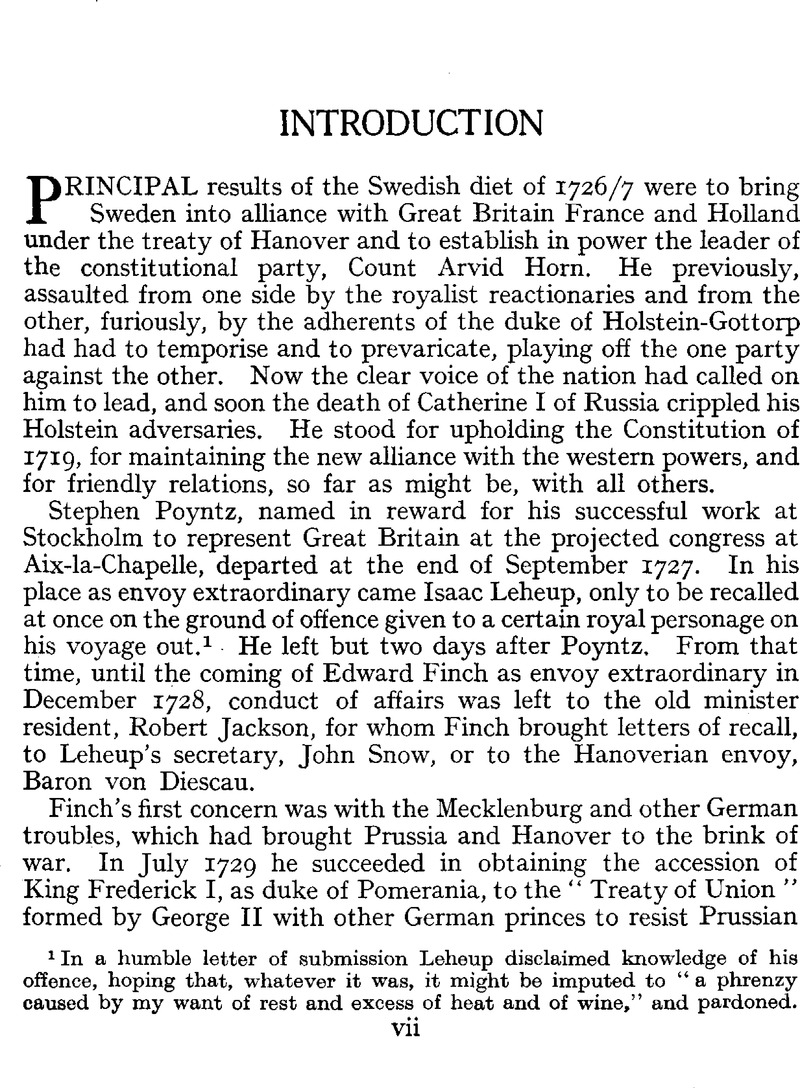No CrossRef data available.
Published online by Cambridge University Press: 24 December 2009

page vii note 1 In a humble letter of submission Leheup disclaimed knowledge of his offence, hoping that, whatever it was, it might be imputed to “a phrenzy caused by my want of rest and excess of heat and of wine,” and pardoned.
page x note 1 A printed copy of the Russian treaty, in Swedish and German, Record Office, Sweden 72. Differences from that of 1724 were that the Polish troubles were specially excepted as a casus fœderis, and that the secret article in favour of the duke of Holstein-Gottorp was dropped, the empress Anne having guaranteed possession of ducal Sleswick to Denmark in 1732.
page xi note 1 Recueil des Instructions, II, 338Google Scholar f. The marquis, named in them Saint-Saurin, was an Italian formerly in the service of the duke of Parma at Paris.
page xii note 1 Record Office, Treaties 259.
page xii note 2 See the instructions to the new French ambassador, the Marquis de Lanmary, Recueil des instructions, II, 352 f.Google Scholar
page xiv note 1 A post “not only the most honourable but the most lucrative and of the greatest influence of any in the kingdom” (Burnaby, 12/23 June 1741).
page xv note 1 See Harrington's dispatch of 18/29 June 1745, page 117.
page xvii note 1 See the instructions to the Marquis d'Havrincourt, French ambassador to Sweden, of 12 May 1757, Recueil des instructions, II, 383 f.Google Scholar
page xvii note 2 See Sandwich's dispatches of 1763–4, pages 140 f.
page xviii note 1 Items of projected expenditure were: for bringing up from the country 300 nobles, who otherwise could not afford the expense, £1050; for maintaining them at the capital for six months, £6300; on elections among the burghers, £1332, and for the secret committee, £1662; for constant maintenance of clubs and societies for the deputies, £3206; for buying the speaker and others of the peasants' order, £2000; for engaging 40 nobles of the French party to leave at the opening of the diet, and obtaining their proxies, £2000; in reserve, and to secure five or six votes of consequence, £2000.
page xix note 1 Record Office, Treaties 537.
page xx note 1 Recueil des instructions, II, 408 f.Google Scholar
page xx note 2 Ibid., pp. 416 f.
page xxi note 1 Goodricke, 28 July 1769, Record Office, Sweden 115.
page xxiii note 1 De Vergennes' successor, Count d'Usson, was reminded in 1774, about the revolution, of “l'intérêt que la France y a pris, et les moyens qu'elle a fourni pour en faciliter le succès ” (Recueil des instructions, II, 444).Google Scholar
page xxiii note 2 Translations, Record Office, Sweden 122 and 125; the former with Goodricke's remarks, the latter as printed in English at Stockholm. For particulars of how the revolution was accomplished, and on the character of Gustavus III, see the Cambridge Modern History, VI, 767 f.Google Scholar
page xxv note 1 Recueil des instructions, II, 469.Google Scholar